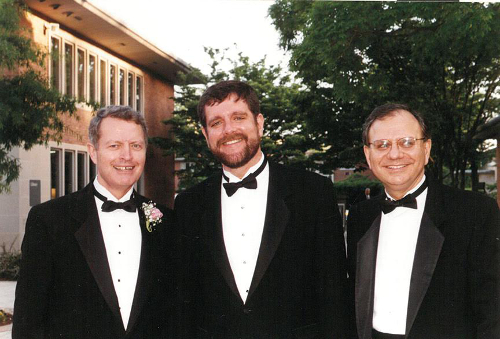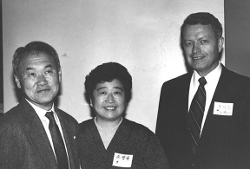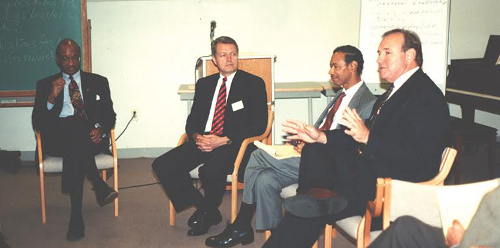| The peripatetic founder of Methodism, John Wesley, on the campus of Wesley Theological Seminary. |
In my second month as president of Wesley Theological Seminary, our audit arrived on my desk with a shocking statement. The seminary was in debt. It might be unable to continue in existence.
How could a seminary like Wesley allow a slow decline in its financial situation to the point of threatening its future existence? Wesley had many assets — an excellent location in Washington, D.C., good facilities, a steady enrollment, and a reputable and dedicated faculty. For the first 18 years after Wesley’s move to Washington, the seminary was growing in enrollment. But there were warning signs too: The seminary achieved an operating surplus in just seven of those first 18 years. And in the succeeding years, a more dramatic decline began, with serious deficits in the operating budget and a growing negative fund balance. The board and the president regularly struggled with the financial situation.
When I accepted the calling to lead Wesley in 1982, I knew it had some financial difficulties. I frankly did not know how serious they were.
Wesley’s precarious financial position had many causes and was only remedied through efforts in multiple areas. But one of those efforts was especially important. We had to build up our fundraising program. During my first few years, I poured my energy not merely into raising money, but also into building a long-term development program.
An example: It become clear right away that Wesley had no effective strategy for generating gift income and had not seriously increased giving to the annual fund for years. I shared my judgment with the committee set up by the board to work with me on the transition. I told them that I knew a little about fundraising and was dedicated to working on it myself. However, I thought we needed a development consultant to help us start from scratch. We selected Tom Broce, who had extensive experience in fundraising and executive leadership.
Team work and hands-on work
There were some basic building blocks on which the new Wesley development program was constructed. The first was hands-on presidential involvement in fundraising. I had never done much direct fundraising, but it was needed, and I was committed to doing it. In doing so, I learned two things quickly. I needed to care about a donor’s interests and needs, but I also always represented Wesley and its needs. Surprisingly, fundraising became fun for me.
The relationships with donors became one of the most meaningful parts of my job. People who invested in Wesley flowed in and out of my life, consciousness, and prayers daily. What were they thinking? What was important to them? When was it appropriate for me to ask them for a gift to Wesley?
The second building block was an excellent staff. The seminary was extremely blessed when Lovett Weems (a successful pastor, Wesley graduate, and former short-list candidate for the Wesley presidency) accepted my offer to become vice president of Wesley Seminary. Like me, he had little direct experience in fundraising, but he was goal driven and exceptionally organized, and he lived and breathed Wesley. He put together a small but effective development staff. (Part of this team was David McAllister-Wilson, at the time a student with drive and a unique capacity to learn. Who would have guessed that he would later become president of Wesley Seminary?)
 |
| As he built fundraising initiatives at Wesley Theological Seminary, President G. Douglass Lewis (left) was helped by a strong team, including future Wesley president David McAllister-Wilson (center) and Lovett Weems (right), who went on to become president of Saint Paul School of Theology in Kansas City. |
A third component was regular meetings with our consultant. At first we all wondered what we would do in two whole days per month with Tom Broce. Only years later did I realize their importance. First, it was a monthly accountability session. Second, we were continually planning our next steps. Broce use to say, “There is lots of shoe leather in fundraising.” From him, we learned that we needed to be out of the office, meeting and talking with people about Wesley and asking for their support.
Broce pushed us to set and pursue concrete goals. We could soon repeat his stories about fundraising successes at other schools after the first sentence emerged from his mouth. Slowly we all became knowledgeable, even experts, in fundraising theory and practice. Still, we had to do it, not just talk about it.
The four essential steps in fundraising
Over the coming years our theory and practice emerged into four simple but essential steps, which required continuing focus. Everything we did revolved around these four central steps.
1 Identify prospective supporters. We constantly looked for persons, groups, and organizations with whom to share the seminary’s story, and we invited them to become a part of the extended Wesley community.
In one of our early monthly meetings, Broce said, “You need to form a Wesley Council made up of folks who give $1,000 or more to Wesley annually.” We all gasped. I did not know one person who I thought could or would give $1,000 to Wesley.
Then he added, “The president should give the first $1,000, and then he should ask the chair of the Wesley board to do likewise.” I had never written a $1,000 check to any charity in my life, much less asked other people — even strangers — to write such a check.
Undaunted, we launched the Council. I did make the first gift, and Wayne Smithey, chair of the board, followed suit. We planned events where we could tell the Wesley story, built lists of prospects for the Council, and produced our first literature about Wesley.
 |
| While building relationships with American donors, Lewis also strengthened Wesley's ties with Methodist educational leaders in Korea and elsewhere around the world. |
At one of our early Council gatherings I spoke about our need to broaden the base of involvement in Wesley. There were two important groups at the seminary, I said. First, there were the on-campus folks engaged daily in the work of Wesley. And second, there were those folks out in communities and churches, who were providing the support for educational work to go on.
I announced: “We call those on campus the ‘in-house’ group. Then there are those, like yourselves, whom we call the ‘out-house’ group.” There was a moment of silence, then laughter.
2 Cultivate long-term relationships. Building a list of donor prospects required knowing two things — did they have an interest in the church and preparing persons for leadership in the church’s ministry? Did they have financial resources?
Over and over, people said to me, “You should go see Frank Purdue and ask him to support Wesley.” Purdue had made millions in the chicken processing business. He attended a United Methodist church on the Eastern Shore of Maryland, a region where more than three-fourths of all United Methodist pastors were Wesley graduates.
I met Frank Purdue, reminded him that all the pastors of his church were Wesley grads, and I asked him for financial support for Wesley. He was gracious, but emphatic. “I try never to give money off the Eastern Shore,” he said. “Especially not to Washington, D.C.”
From this encounter, I learned that simply having money does not make someone into a donor. They must have motivation as well as means. And I learned that Wesley could not build its future by quickly getting a few major gifts from chicken farmers.
Development is a long-term proposition, beginning with a core group of individuals who believe in and invest in the seminary, and it extends outward from there. One giver connects you with the next one. Sometimes it feels excruciatingly slow, even hopeless. The cultivation process never ends, even after the person becomes a regular donor.
Late in our first year we began a “special event” strategy that combined affirming current donors and cultivating new ones. We invited Wesley Council members, members of the board, and new prospects for lunch at the seminary followed by a tour of a special place or event in Washington. Some Wesley faculty members joined the group. This built a growing community of people who knew each other and felt a common investment in the seminary.
To build a sustainable future for Wesley, we wanted three kinds of gifts from every person. First, we needed an annual gift. We had annual fund goals to insure that Wesley generated income necessary to balance its budget. Making an annual gift also kept a person connected to Wesley on a continuing basis.
Second, we wanted a capital gift, a large gift for a designated purpose. Most annual donors to a school will at some point make a gift of at least 10 times their annual gift. Rarely can a development effort gain a capital gift from someone who has never given to the institution before.
Third, we wanted to be in the estate plan of every donor. This usually happens only when a person has had a long-term relationship with the school and its mission. It requires special persistence, nurture, and often assistance to help the donor to make that decision and act on it.
3 Ask clearly and let the donor decide. Broce reminded us that Wesley would receive very few checks that we did not ask for. He was right. One member of the Wesley board advised us, “You do not have to protect donors; they will do that for themselves. You must make sure they have the opportunity to consider a gift decision that only they can make.”
I came to understand that people expected me to ask them for support for the seminary’s mission. The more specific I could be about an amount and a purpose for the gift, the more helpful it was to an individual donor. They wanted something concrete to consider and a vision for how they could contribute. I also learned that any fundraising style that feels like manipulation was a turn off. Many times their decision disappointed me, but I tried never to let that influence how I continued to relate to them and affirm them.
 |
| Under Lewis's leadership, Wesley reconfirmed its commitment to the city of Washington,D.C. Here he and academic dean Douglas Meeks (right) meet with African American church leaders. |
4 Express gratitude — and do it quickly. Nothing in development work is more important than thanking a donor for a gift. If a thank you comes too long afterwards, the donor may have forgotten the gift. That neglected giver is more likely to forget to give in the future.
Early on I began signing and adding a note to every gift acknowledgement of $100 or more. I also wrote a personal letter for each Wesley Council gift. In my 20 years as president of Wesley, I do not know how many personal thank-you’s I sent. What I do know is that each one, even in a small way, contributed to the bond between the members of our growing support constituency and Wesley Seminary.
The payoff
The fundraising results for my first year far exceeded our expectations. We had goals in that year’s budget for operating and scholarship income of $424,000 — a very high mountain to climb, since Wesley had raised only $309,000 the previous year. We did not concentrate on the dollar goal but focused on the number of new Wesley Council gifts we could generate. In the end, this number almost tripled the number from preceding year. In total gifts for all purposes, we raised almost twice the amount of the preceding year. That was a morale boost for the whole Wesley Seminary community, and it was the beginning of an institution-wide reorientation.